Reflections on Developing Intercultural Communication Competencies
VerifiedAdded on 2023/06/14
|6
|1000
|83
Essay
AI Summary
This essay reflects on the development of intercultural communication competencies through the analysis of digital artifacts and personal experiences. It discusses the importance of intercultural communication in leadership, the benefits of intercultural communication studies in improving competence, and the impact of intercultural competence on social identity. The reflections highlight how the learning experience has influenced the student's personal activities and thought processes, fostering confidence in communicating with individuals from diverse cultural backgrounds. The essay emphasizes the significance of understanding and respecting different cultures to avoid misunderstandings and promote effective communication in various settings.
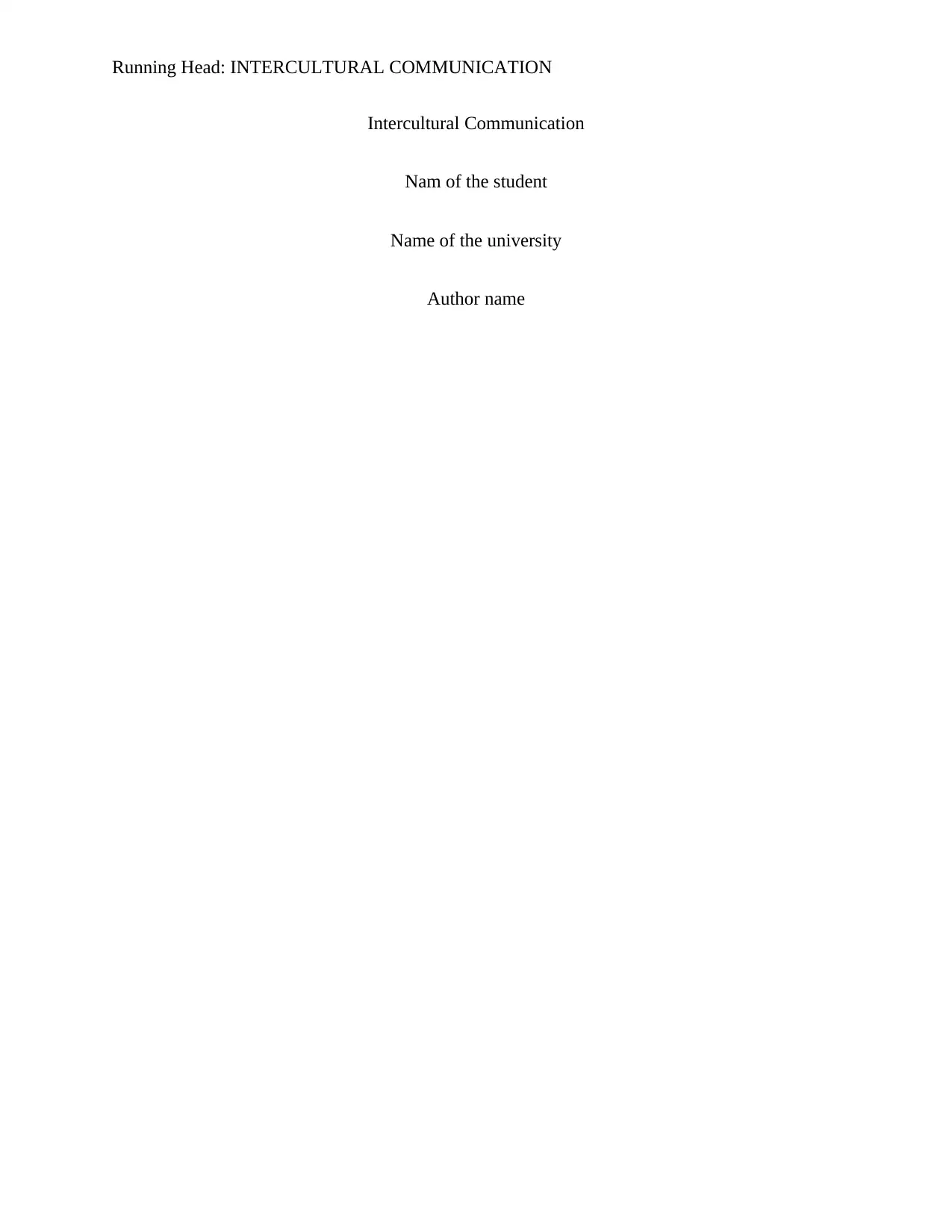
Running Head: INTERCULTURAL COMMUNICATION
Intercultural Communication
Nam of the student
Name of the university
Author name
Intercultural Communication
Nam of the student
Name of the university
Author name
Paraphrase This Document
Need a fresh take? Get an instant paraphrase of this document with our AI Paraphraser
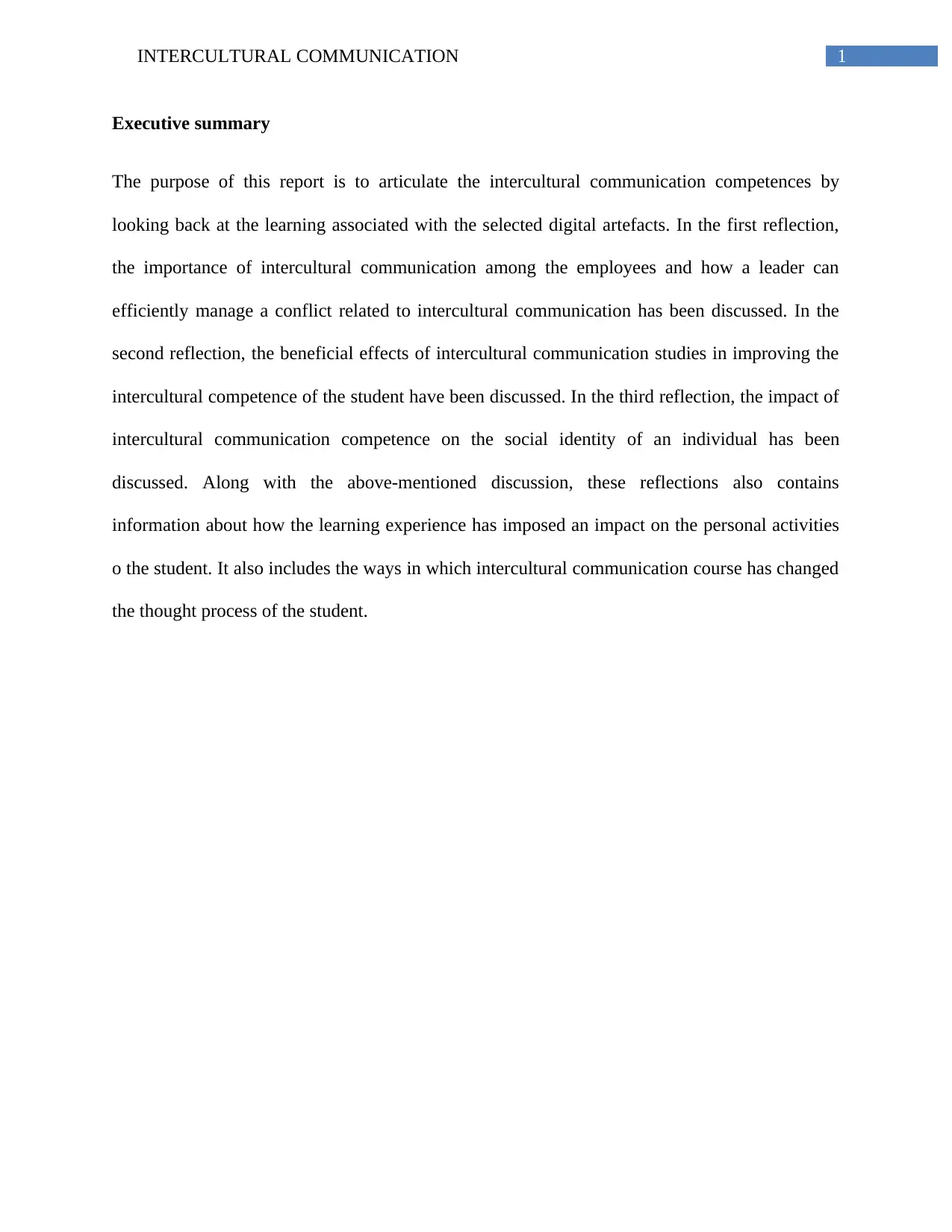
1INTERCULTURAL COMMUNICATION
Executive summary
The purpose of this report is to articulate the intercultural communication competences by
looking back at the learning associated with the selected digital artefacts. In the first reflection,
the importance of intercultural communication among the employees and how a leader can
efficiently manage a conflict related to intercultural communication has been discussed. In the
second reflection, the beneficial effects of intercultural communication studies in improving the
intercultural competence of the student have been discussed. In the third reflection, the impact of
intercultural communication competence on the social identity of an individual has been
discussed. Along with the above-mentioned discussion, these reflections also contains
information about how the learning experience has imposed an impact on the personal activities
o the student. It also includes the ways in which intercultural communication course has changed
the thought process of the student.
Executive summary
The purpose of this report is to articulate the intercultural communication competences by
looking back at the learning associated with the selected digital artefacts. In the first reflection,
the importance of intercultural communication among the employees and how a leader can
efficiently manage a conflict related to intercultural communication has been discussed. In the
second reflection, the beneficial effects of intercultural communication studies in improving the
intercultural competence of the student have been discussed. In the third reflection, the impact of
intercultural communication competence on the social identity of an individual has been
discussed. Along with the above-mentioned discussion, these reflections also contains
information about how the learning experience has imposed an impact on the personal activities
o the student. It also includes the ways in which intercultural communication course has changed
the thought process of the student.
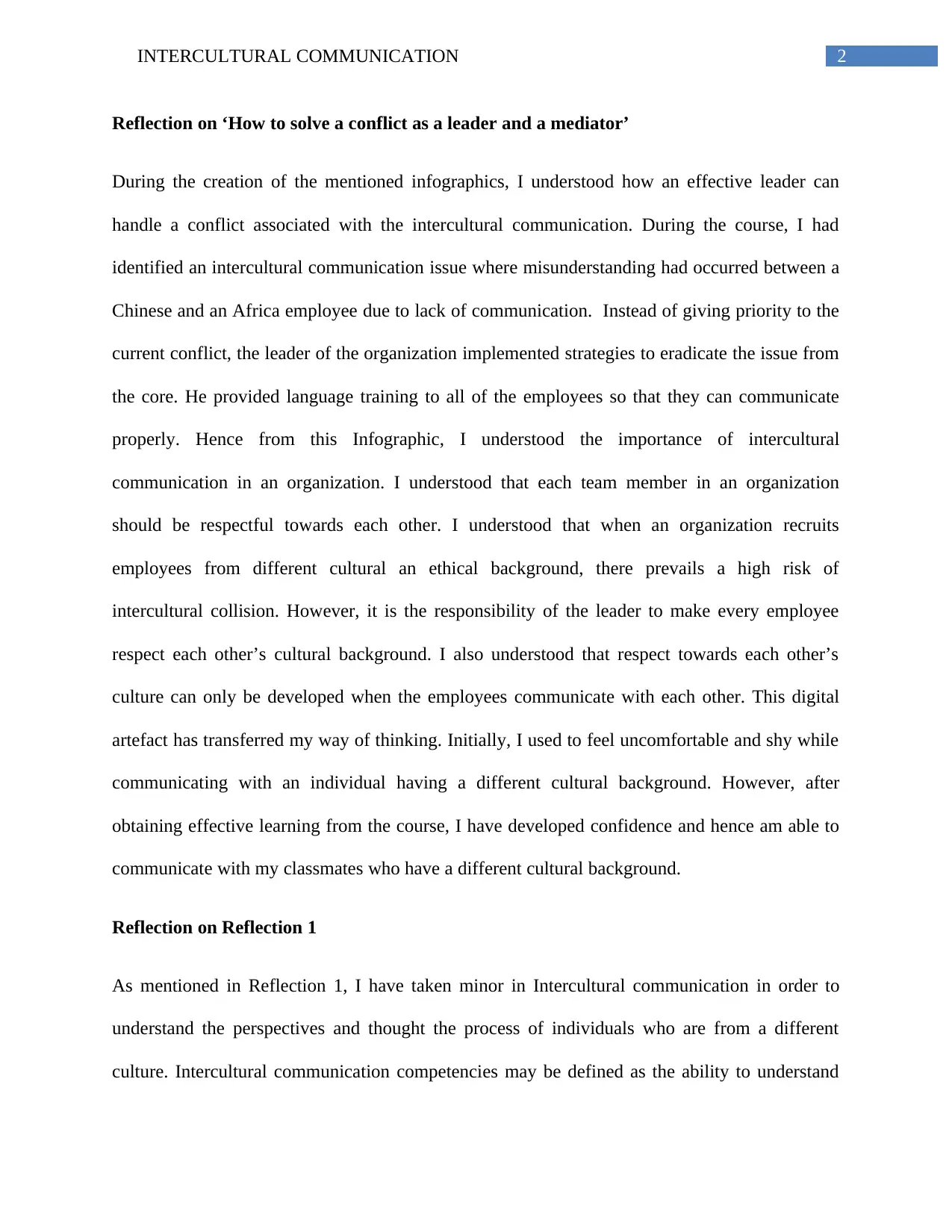
2INTERCULTURAL COMMUNICATION
Reflection on ‘How to solve a conflict as a leader and a mediator’
During the creation of the mentioned infographics, I understood how an effective leader can
handle a conflict associated with the intercultural communication. During the course, I had
identified an intercultural communication issue where misunderstanding had occurred between a
Chinese and an Africa employee due to lack of communication. Instead of giving priority to the
current conflict, the leader of the organization implemented strategies to eradicate the issue from
the core. He provided language training to all of the employees so that they can communicate
properly. Hence from this Infographic, I understood the importance of intercultural
communication in an organization. I understood that each team member in an organization
should be respectful towards each other. I understood that when an organization recruits
employees from different cultural an ethical background, there prevails a high risk of
intercultural collision. However, it is the responsibility of the leader to make every employee
respect each other’s cultural background. I also understood that respect towards each other’s
culture can only be developed when the employees communicate with each other. This digital
artefact has transferred my way of thinking. Initially, I used to feel uncomfortable and shy while
communicating with an individual having a different cultural background. However, after
obtaining effective learning from the course, I have developed confidence and hence am able to
communicate with my classmates who have a different cultural background.
Reflection on Reflection 1
As mentioned in Reflection 1, I have taken minor in Intercultural communication in order to
understand the perspectives and thought the process of individuals who are from a different
culture. Intercultural communication competencies may be defined as the ability to understand
Reflection on ‘How to solve a conflict as a leader and a mediator’
During the creation of the mentioned infographics, I understood how an effective leader can
handle a conflict associated with the intercultural communication. During the course, I had
identified an intercultural communication issue where misunderstanding had occurred between a
Chinese and an Africa employee due to lack of communication. Instead of giving priority to the
current conflict, the leader of the organization implemented strategies to eradicate the issue from
the core. He provided language training to all of the employees so that they can communicate
properly. Hence from this Infographic, I understood the importance of intercultural
communication in an organization. I understood that each team member in an organization
should be respectful towards each other. I understood that when an organization recruits
employees from different cultural an ethical background, there prevails a high risk of
intercultural collision. However, it is the responsibility of the leader to make every employee
respect each other’s cultural background. I also understood that respect towards each other’s
culture can only be developed when the employees communicate with each other. This digital
artefact has transferred my way of thinking. Initially, I used to feel uncomfortable and shy while
communicating with an individual having a different cultural background. However, after
obtaining effective learning from the course, I have developed confidence and hence am able to
communicate with my classmates who have a different cultural background.
Reflection on Reflection 1
As mentioned in Reflection 1, I have taken minor in Intercultural communication in order to
understand the perspectives and thought the process of individuals who are from a different
culture. Intercultural communication competencies may be defined as the ability to understand
⊘ This is a preview!⊘
Do you want full access?
Subscribe today to unlock all pages.

Trusted by 1+ million students worldwide
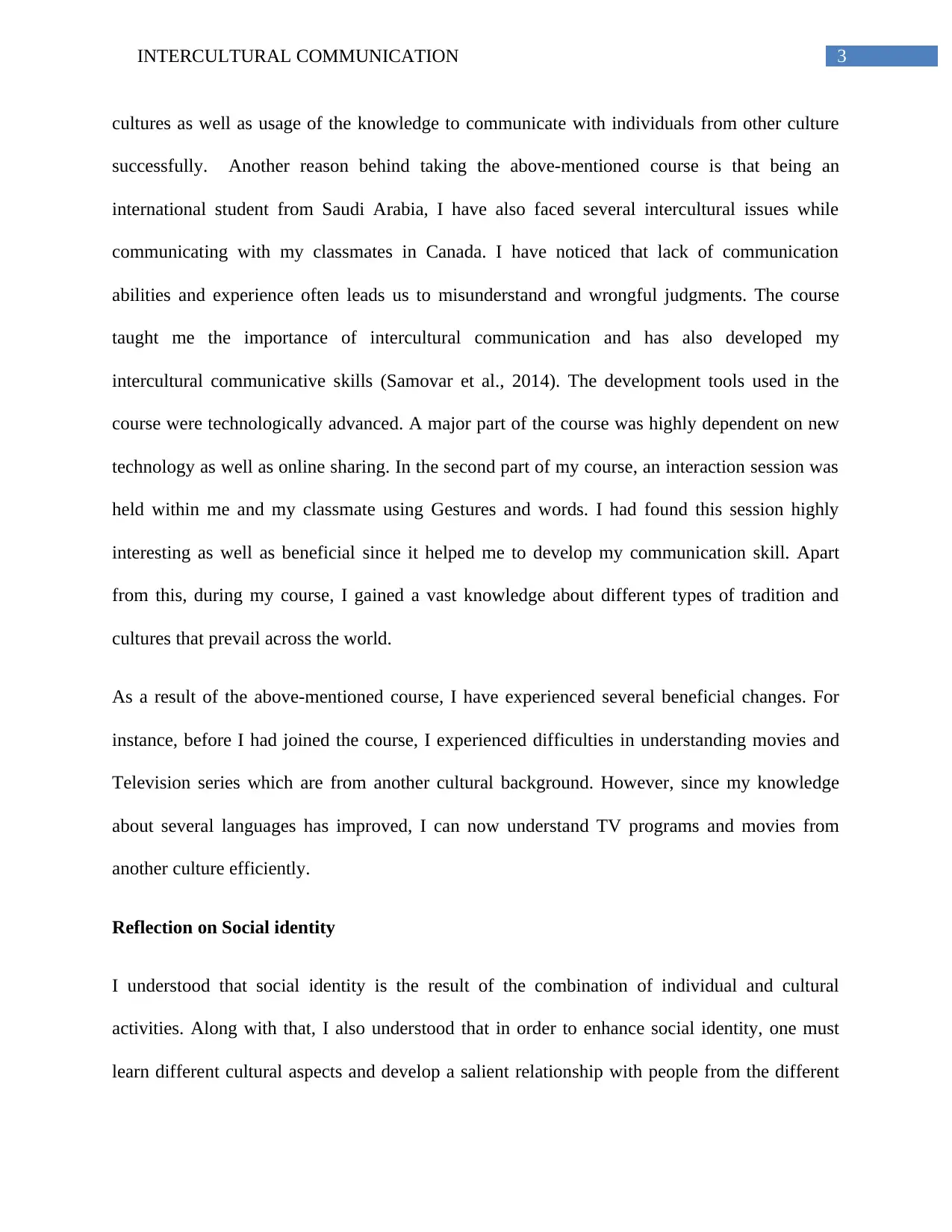
3INTERCULTURAL COMMUNICATION
cultures as well as usage of the knowledge to communicate with individuals from other culture
successfully. Another reason behind taking the above-mentioned course is that being an
international student from Saudi Arabia, I have also faced several intercultural issues while
communicating with my classmates in Canada. I have noticed that lack of communication
abilities and experience often leads us to misunderstand and wrongful judgments. The course
taught me the importance of intercultural communication and has also developed my
intercultural communicative skills (Samovar et al., 2014). The development tools used in the
course were technologically advanced. A major part of the course was highly dependent on new
technology as well as online sharing. In the second part of my course, an interaction session was
held within me and my classmate using Gestures and words. I had found this session highly
interesting as well as beneficial since it helped me to develop my communication skill. Apart
from this, during my course, I gained a vast knowledge about different types of tradition and
cultures that prevail across the world.
As a result of the above-mentioned course, I have experienced several beneficial changes. For
instance, before I had joined the course, I experienced difficulties in understanding movies and
Television series which are from another cultural background. However, since my knowledge
about several languages has improved, I can now understand TV programs and movies from
another culture efficiently.
Reflection on Social identity
I understood that social identity is the result of the combination of individual and cultural
activities. Along with that, I also understood that in order to enhance social identity, one must
learn different cultural aspects and develop a salient relationship with people from the different
cultures as well as usage of the knowledge to communicate with individuals from other culture
successfully. Another reason behind taking the above-mentioned course is that being an
international student from Saudi Arabia, I have also faced several intercultural issues while
communicating with my classmates in Canada. I have noticed that lack of communication
abilities and experience often leads us to misunderstand and wrongful judgments. The course
taught me the importance of intercultural communication and has also developed my
intercultural communicative skills (Samovar et al., 2014). The development tools used in the
course were technologically advanced. A major part of the course was highly dependent on new
technology as well as online sharing. In the second part of my course, an interaction session was
held within me and my classmate using Gestures and words. I had found this session highly
interesting as well as beneficial since it helped me to develop my communication skill. Apart
from this, during my course, I gained a vast knowledge about different types of tradition and
cultures that prevail across the world.
As a result of the above-mentioned course, I have experienced several beneficial changes. For
instance, before I had joined the course, I experienced difficulties in understanding movies and
Television series which are from another cultural background. However, since my knowledge
about several languages has improved, I can now understand TV programs and movies from
another culture efficiently.
Reflection on Social identity
I understood that social identity is the result of the combination of individual and cultural
activities. Along with that, I also understood that in order to enhance social identity, one must
learn different cultural aspects and develop a salient relationship with people from the different
Paraphrase This Document
Need a fresh take? Get an instant paraphrase of this document with our AI Paraphraser
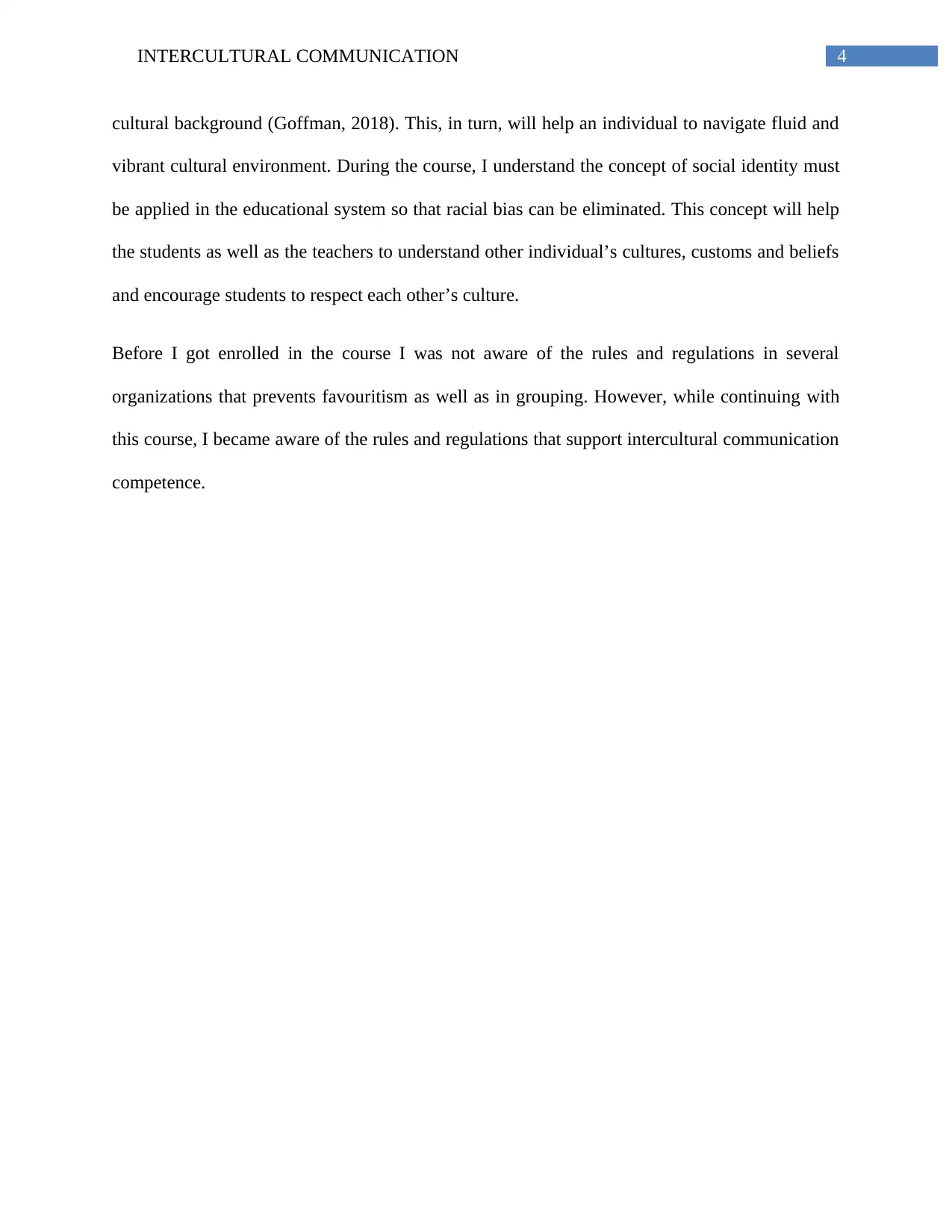
4INTERCULTURAL COMMUNICATION
cultural background (Goffman, 2018). This, in turn, will help an individual to navigate fluid and
vibrant cultural environment. During the course, I understand the concept of social identity must
be applied in the educational system so that racial bias can be eliminated. This concept will help
the students as well as the teachers to understand other individual’s cultures, customs and beliefs
and encourage students to respect each other’s culture.
Before I got enrolled in the course I was not aware of the rules and regulations in several
organizations that prevents favouritism as well as in grouping. However, while continuing with
this course, I became aware of the rules and regulations that support intercultural communication
competence.
cultural background (Goffman, 2018). This, in turn, will help an individual to navigate fluid and
vibrant cultural environment. During the course, I understand the concept of social identity must
be applied in the educational system so that racial bias can be eliminated. This concept will help
the students as well as the teachers to understand other individual’s cultures, customs and beliefs
and encourage students to respect each other’s culture.
Before I got enrolled in the course I was not aware of the rules and regulations in several
organizations that prevents favouritism as well as in grouping. However, while continuing with
this course, I became aware of the rules and regulations that support intercultural communication
competence.
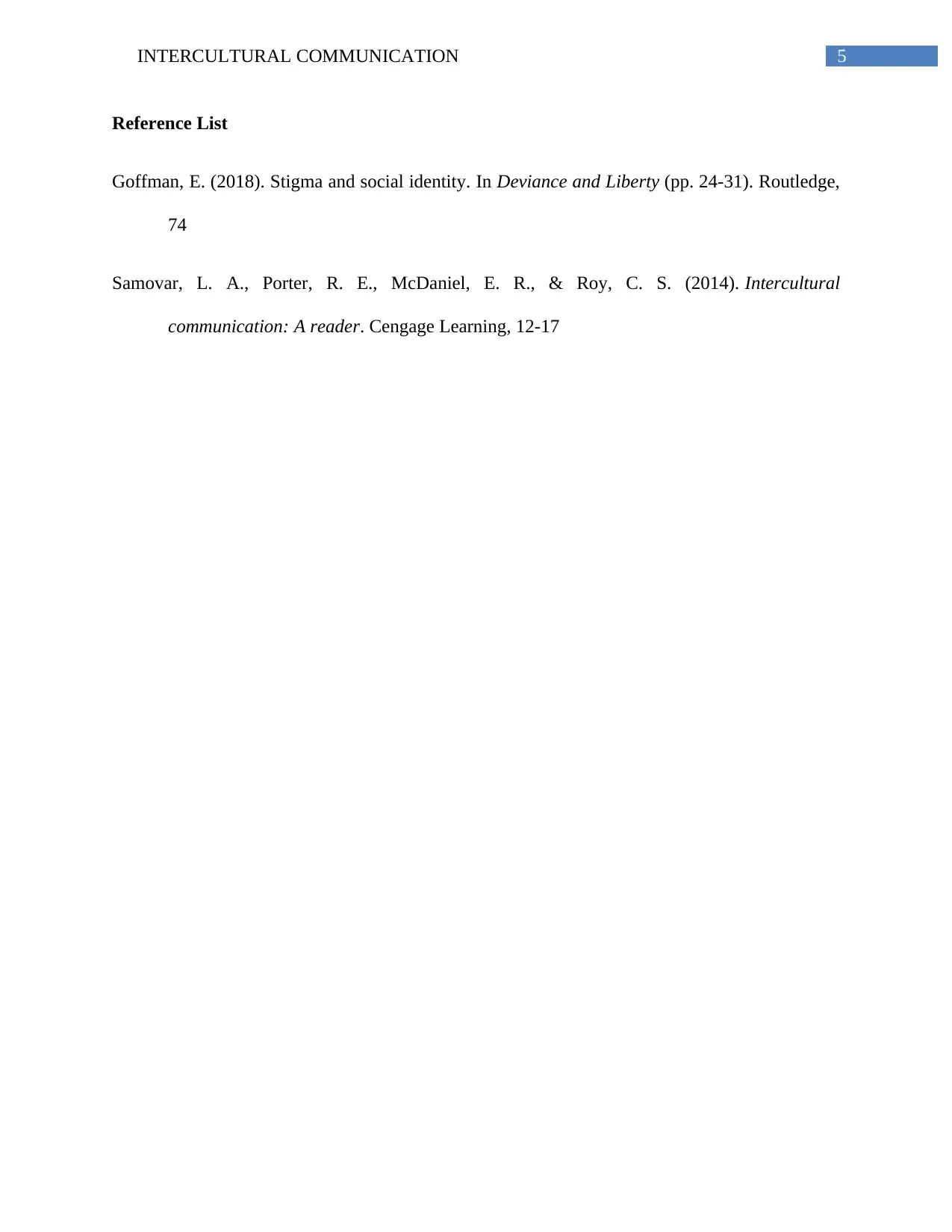
5INTERCULTURAL COMMUNICATION
Reference List
Goffman, E. (2018). Stigma and social identity. In Deviance and Liberty (pp. 24-31). Routledge,
74
Samovar, L. A., Porter, R. E., McDaniel, E. R., & Roy, C. S. (2014). Intercultural
communication: A reader. Cengage Learning, 12-17
Reference List
Goffman, E. (2018). Stigma and social identity. In Deviance and Liberty (pp. 24-31). Routledge,
74
Samovar, L. A., Porter, R. E., McDaniel, E. R., & Roy, C. S. (2014). Intercultural
communication: A reader. Cengage Learning, 12-17
⊘ This is a preview!⊘
Do you want full access?
Subscribe today to unlock all pages.

Trusted by 1+ million students worldwide
1 out of 6
Related Documents
Your All-in-One AI-Powered Toolkit for Academic Success.
+13062052269
info@desklib.com
Available 24*7 on WhatsApp / Email
![[object Object]](/_next/static/media/star-bottom.7253800d.svg)
Unlock your academic potential
Copyright © 2020–2025 A2Z Services. All Rights Reserved. Developed and managed by ZUCOL.





